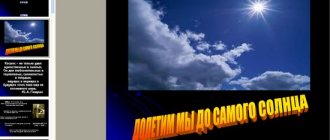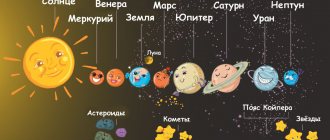What is a rainbow
A rainbow is an optical phenomenon caused by the interaction of sunlight and water droplets in the atmosphere. It is a luminous multi-colored arc.
It can be seen at high air humidity, usually immediately after rain or during it, provided that the Sun freely penetrates through the clouds and is behind the observer.
Progress of the experiment: For the experiment we will need:
CD;
flashlight.
I took the CD in my hands and began to direct the beam of the turned-on flashlight at it. A sunbeam appeared on the wall , but with a certain rotation of the disk, the wall was painted in different colors - a rainbow appeared .
Conclusion: Light is refracted on the mirror surface of the disk, similar to the refraction of sunlight in a drop of water. That's why we can see a rainbow .
3.3 Experiment III
Project "Colorful Rainbow"
Research project
"Colorful Rainbow"
Project theme: “Multi-colored rainbow.”
Type of project: creative - experimental.
Duration: long term.
Author of the work: student of the senior group - Anastasia Kachmasheva.
Project manager: teacher of the senior group - Ermolina L.A.
Educational area: cognitive development.
Relevance: The world that surrounds us is beautiful and diverse. But people are paying less and less attention to the beauty and diversity of natural phenomena that bring joy and peace. Everyday worries dull people's natural curiosity and desire to learn new things. Sometimes it seems that people have stopped paying attention even to what is familiar from childhood. Every adult, thinking about a rainbow, remembers his childhood. It was in childhood that I wanted to know what a rainbow is, where it comes from, why it is so beautiful. The task of adults is to stimulate children’s natural curiosity, the desire to make their first discoveries, conduct research, and believe in their strengths and abilities. Research to familiarize yourself with the natural phenomenon of the rainbow is a very interesting and vivid experience that can reveal creativity, initiative and independence in a child.
Objective of the project:
- development of creative experimental and research abilities of children.
Tasks:
- find out as much information as possible about the rainbow as a natural phenomenon;
- learn through experiments how a rainbow appears;
- find information about rainbows in various sources;
- introduce the children of the group to this phenomenon;
- promote the development of research abilities, curiosity and independence.
Hypothesis:
- the method of research and experimentation will help you become more familiar with the beautiful natural phenomenon - the rainbow;
- Rainbows are a natural phenomenon, but they can be created at home.
The role of the child in the implementation of the project:
- participation in the discussion of the topic and goals of the project;
- studying the proposed material;
- putting forward proposals for work on the project;
- participation in collecting materials on the topic;
- conducting research and experiments under the guidance of a teacher;
- active participation in the design of work results (albums, folders, artwork - drawings and crafts).
Role of the project manager:
- ensuring the interest of the child and his parents in working on the topic;
- provision of literature;
- encouraging the child to engage in independent, conscious work;
- constant but unobtrusive assistance and monitoring of the child’s work.
The role of parents in the implementation of the project:
- participation in collecting materials on the topic;
- consultations on the topic;
- participation in experimental activities of children at home.
Expected result:
- the child must receive primary knowledge about the natural phenomenon - the rainbow;
- the child has an understanding of experimental activities and can conduct a number of experiments and experiments himself;
- the child is familiar with the phenomenon of the rainbow and understands its origin;
- the child understands the beauty of a natural phenomenon - a rainbow, and admires it.
Estimated product of project activity:
- Album “Rainbow - Arc” (poems, riddles, signs);
- Album “Rainbow - Arc” (experiments and experiments);
- Creative works (drawings, layouts, crafts);
- Project "Colorful Rainbow".
Project implementation forms:
- Conversation and observations of NOD;
- Experimental and research activities;
- Artistic and visual activities.
Stages of work on the project:
Stage 1: preparatory.
- Discussion of work on the project with the child and parents;
- Determining the topic, goals and directions of work;
- Development of a plan for working on the topic;
- Selection of fiction and methodological literature;
- Purchasing the necessary video materials.
Stage 2: main.
- A series of conversations;
- Acquaintance with poems, riddles, folk signs;
- Watching videos demonstrating a natural phenomenon - a rainbow;
- Reading and viewing encyclopedias;
- Experiments on making rainbows at home;
- Artistic creativity - creating drawings, models, crafts.
Stage 3: final.
- Summing up the work;
- Design of the album “Rainbow - Arc” (poems, riddles, signs);
- Design of the album “Rainbow - Arc” (experiments and experiments);
- Exhibition of creative works on the theme “Multi-colored rainbow” (drawings, layouts, crafts);
- Design of the project “Multi-colored rainbow”.
- Defense of the project at the municipal stage of the “I am a Researcher” competition.
Types of rainbow
Scientists distinguish different types of rainbows depending on the size of the drops, the intensity of light and the height of the Sun above the surface of the earth.
Sometimes you can see a second rainbow, less bright, around the first:
This occurs when the sun's rays are reflected inside the droplet twice before reaching the surface. The intensity of the light flux weakens, and the multi-colored strip appears “inverted” - the purple color appears at the top. As a result, a double rainbow appears in the sky. The celestial sector between two arcs usually has a darker hue than outside them. This area is called the Alexander Stripe, named after the Ancient Greek philosopher Alexander of Aphrodisias, who first described this effect in the 2nd century AD. e.
A triple rainbow is much less common in nature:
This is possible when the rays are reflected three times inside the drops. In this case, a third-order arc is formed, weaker than the previous two.
The sun's ray passing through large drops is weakened and creates a more diffuse spectrum. The color and brightness of the Sun changes at dawn and dusk. Sunset light travels the maximum distance to the observer's eyes, which is accessible to the long-wavelength part of the spectrum. Therefore, a red rainbow is found - with a predominance of red and orange stripes:
And if rain, rainbows and the Sun are a familiar combination observed most often, then in the absence of the Sun or rain, an atmospheric phenomenon can take on the most unusual forms.
Unusual species
Unusual and rare types of rainbows include:
- lunar;
- foggy;
- fiery.
A lunar rainbow, otherwise called a night rainbow, is much less common in nature than the usual daytime one. It occurs during the full phase of the moon in moist air. The Moon should be in a clear sky less than 42° above the horizon, and the observer should be between the Moon and the rain. Similar phenomena are known over waterfalls:
The human eye's color-detecting receptors are inactive in low light. Therefore, a night rainbow is perceived by vision as white, in contrast to the colorful daytime one. However, you can see the entire spectrum in a long exposure photo.
For a fog rainbow instead of rain and sun, a combination of fog with sunlight or moonlight is required. Since the drops of moisture in this case are very small (their radius is no more than 0.05 mm), the light in them cannot always be scattered in the form of a spectrum. This phenomenon looks like a halo of white color, which is why the phenomenon is sometimes called a white rainbow. In this case, the outer contours of the arc can be painted purple and orange:
One of the rarest weather phenomena is a fire rainbow . It looks like a horizontal arc against the background of light cirrus clouds. That is why it is also called a rainbow with clouds. Thanks to the huge radius, the arc line appears straight, extending parallel to the horizon for hundreds of kilometers:
For its appearance, three factors are necessary:
- cirrus clouds in the sky;
- flat hexagonal ice crystals arranged horizontally in clouds;
- the height of the Sun is at least 58° above the horizon.
The latter condition makes it impossible to observe this phenomenon from the earth's surface at latitudes below 55°, where the Sun does not rise so high. The situation can be corrected by climbing a high mountain.
The ice crystals should lie horizontally in the air, which is quite rare. The sun's rays penetrate through the side walls of the crystals and, being refracted, exit through the lower horizontal face. Clouds in the rays of the spectrum flash with rainbow light.
A fire rainbow is considered a type of halo.
Progress of the experiment: For the experiment we will need:
triangular transparent prism.
I took the prism in my hands and brought it to the window, the sun's rays began to pass through it, thanks to which a rainbow appeared .
Thanks to these experiments, we can conclude that our hypothesis was confirmed. Rainbow can be obtained at home.
Conclusion: the sun's rays, passing through a prism (as in the case of water, are refracted, that is, decomposed into their component parts - seven colors of the rainbow .
Experiment IV
Interesting Facts
- The perception of the spectrum differs among different peoples. According to Newton's classification, blue and dark blue are replaced by blue and its darker shade - indigo. Modern Englishmen distinguish 6, not 7, primary colors: they do not divide blue into dark or light shades. And in the Japanese tradition, green is present only as a shade of blue.
- A third-order (triple) rainbow is far from the limit. The human eye simply does not perceive multiple, but weaker reflections of spectra. In laboratory conditions, using a laser setup, researchers obtained a rainbow of order two hundred.
- Typically perceived as an arc, the shape of a rainbow can be circular when viewed from a great height, such as from an airplane:
A circular rainbow results from the spherical shape of the drops. The reflected light forms a circle, the center of which is in line with the observer's eye. Therefore, a person standing on the ground cannot see the lower half of the arc.
A rainbow is just an optical effect, explained by science. It is not located in a specific place and, like the horizon line, cannot be approached. What each of us sees depends on the place of observation and our position relative to the Sun or other light source.
What time of year does a rainbow occur? Almost any time. It's just that in winter the moisture is replaced by ice crystals. Therefore, you can always observe this miracle of nature when there is a strong light source and weather conditions for its transformation into a spectrum.
Similar phenomena
At low air temperatures, you can see similar atmospheric phenomena:
- halo;
- inverted rainbow;
- ring rainbow.
In frosty winter, a luminous halo sometimes appears around the Sun and Moon. This effect is called a halo. It occurs near strong light sources (sometimes around street lights) and is caused by light passing through ice crystals in the lower atmosphere. The type of this phenomenon depends on the shape of the crystals and their location. Sometimes light, when refracted, is decomposed into a spectrum, and then the halo becomes like an annular rainbow:
An inverted rainbow appears in high cirrus clouds made of ice crystals when the Sun shines down on them. A downward curved arc is formed, where the lower edge is red and the upper edge is purple:






